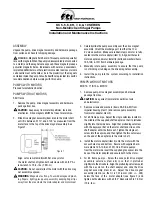
16
254 and 254OS Pneudraulic Installation Tools (HK1172)
Troubleshooting
1. Tool fails to operate when trigger is pressed.
a. Air line not connected.
b. Worn or damaged throttle valve O-rings.
c Broken throttle valve cable
.
2. Tool does not complete fastener installation and
break pintail.
a.
Air pressure too low
.
b.
Worn or damaged air piston Quad-ring
.
c. Tool is low on hydraulic fluid
. See the
Fill and
Bleed
section.
d. Air in hydraulic system. See
Fill and Bleed
.
e. Worn or damaged r
eservoir springs.
f. Check for piston drift.
3. Pintail stripped and/or swaged collar not ejected.
a. Check for broken or worn jaws in nose assembly.
See
Nose Assembly Data Sheet
.
b. Check for loose retaining or lock nut.
c. Check for piston drift.
4.
Hydraulic fluid exhausts with air or leaks at base
of handle.
a. Worn or damaged gland assembly. Inspect
Polyseal, O-rings, Quad-ring, and Back-up ring
.
R
eplace if necessary.
5. Tool has piston drift.
a.
Loose collet crashing into the front of the anvil
causing the relief valve to open. Tighten the
collet. See
Fill and Bleed
.
b. Worn or damaged return pressure relief valve.
Inspect seat, O-ring, Back-up rings, ball, and
valve spring. Replace if necessary.
c. Worn or damaged Intensifier Piston Assembly.
Inspect O-rings and Back-up rings. Replace if
necessary.
6.
Hydraulic fluid leaks at rear of pull piston.
a.
Worn or damaged rear gland. Inspect O-rings
and Back-up rings
. R
eplace if necessary.
7.
Hydraulic fluid leaks at front of pull piston.
a.
Worn or damaged front gland. Inspect Polyseal.
Replace if necessary
.
8. Pull piston will not return.
a. Throttle valve stuck; lubricate O-rings.
b. Throttle arm, cable, or trigger binding.
9. Air leaks at air cylinder head.
a. Worn or damaged O-ring. Replace if necessary.
Always check the simplest possible cause (such as a loose or disconnected trigger line) of a malfunction first. Then
proceed logically, eliminating other possible causes until the cause is discovered. Where possible, substitute known
good parts for suspected defective parts. Use this Troubleshooting information to aid in locating and correcting
trouble.
NOTE: “Piston drift” is when the air piston is in the down position, but the hydraulic pull piston is not
in the full-forward position. This causes an out-of-sequence condition.



































